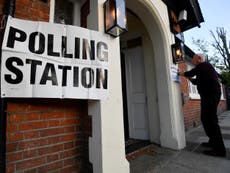The local elections mostly passed the Lib Dems by – so much for support for a second referendum
The party on average enjoyed a modest advance of three points on their 2014 vote. But the party’s performance in the local elections that year was one of its worst ever


It was always a risk. Remain-voting London might swing to the Labour Party in the local elections, but not enough to bring it much in the way of council gains. Meanwhile, Leave-voting England outside the capital might witness a shift to the Conservatives, leaving Labour struggling to avoid overall losses.
And so it transpired. In London there was a swing from the Conservatives to Labour, but, at 2 per cent since 2014, when the seats contested on Thursday were last fought, it was too small to wrest from the Tories their totemic trophies of Wandsworth and Westminster. And Barnet, which was seemingly much easier to win, also failed to land in Labour’s lap, as the party has tended to struggle in wards with a large Jewish community. In any event the Barnet result seems set to add new fuel to the row in Labour’s ranks about antisemitism.
Meanwhile, outside London, there was indeed a small swing of 1 per cent to the Conservatives. However, their performance varied substantially. The party advanced most strongly in areas where Ukip had turned in its best performances in 2014, and most of these places voted heavily for Leave.
Former Ukip supporters typically switched to the Conservatives much more heavily than they did to Labour. These voters’ behaviour helped seal Labour’s fate in Derby, Nuneaton and Redditch, and ensured that the party failed to capture key targets such as Amber Valley and Walsall.
In contrast, the Conservatives found it more difficult to fend off Labour’s challenge in Remain-voting areas where former Ukip supporters were thinner on the ground. This was reflected in the Tory party’s loss of Trafford – the one metropolitan district that was still in the party’s grasp – and of Richmond-upon-Thames and South Cambridgeshire, where the Liberal Democrats claimed victories.
The net effect of these diverse but limited swings was to leave the Conservatives and Labour neck and neck with each other when the BBC attempted to project the parties’ local election performance into the equivalent of a general election outcome. Both parties were estimated to be on 35 per cent.
This is a higher share of the projected vote for Labour than in any annual round of local elections since 2012, and to that extent can be regarded as evidence of progress. However, under the first past the post electoral system what matters is not a party’s absolute share of the vote but how well it does compared with its rivals. In every round of elections in the 2010-15 parliament, as well as in 2016, Labour was narrowly ahead of the Conservatives. This time they are only on equal footing.
The Conservatives’ projected share is three points down on last year, but it is better than the party’s performance in four of the five rounds of elections held between 2012 and 2016. The ruling party will doubtless feel that this is not a bad position to be in after eight years in government.
Politics is not just about statistics. Expectations matter. Because Labour had allowed people to think that it might make big gains when in the event it is no more than neck and neck with the Conservatives, and has emerged virtually empty-handed so far as councils are concerned, the result inevitably looks like a disappointment.
The Liberal Democrats on average enjoyed a modest advance of three points on their 2014 vote. But the party’s performance in the local elections that year was one of its worst ever. Meanwhile, at 16 per cent, the party’s projected share is a couple of points down on its performance in last year’s county council elections. Such a modest tally can hardly be regarded as evidence that the party has finally begun to turn the corner following its disastrous loss of support during the years of coalition with the Conservatives.
However, what will particularly encourage the party is that it performed best in wards where four years ago it shared first and second places with the Conservatives and where therefore it had some prospect of making gains. In many such wards, it was seemingly helped by a tactical squeeze on the Labour vote. That said, there is still little sign that the party’s opposition to Brexit is helping it to gain ground across the board amongst Remain voters – on average the party’s vote increased just as much in Leave-voting areas as in Remain-backing ones.
Brexit may be continuing to reshape the battle between Labour and the Conservatives, but it still appears to be largely passing the Liberal Democrats by.
Sir John Curtice is a professor of politics at Strathclyde University


Join our commenting forum
Join thought-provoking conversations, follow other Independent readers and see their replies